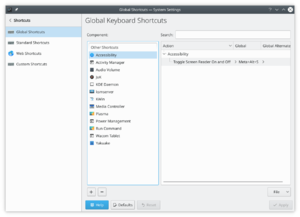System Settings/Shortcuts and Gestures/pt-br: Difference between revisions
(Created page with "Clique em <menuchoice>Nova ação</menuchoice> e selecione a página <menuchoice>Disparar</menuchoice>. no fundo da tela existe um botão <menuchoice>Editar</menuchoice> (clique ...") |
(Created page with "====Para associar a uma ação====") |
||
| Line 48: | Line 48: | ||
no fundo da tela existe um botão <menuchoice>Editar</menuchoice> (clique nele). Na caixa aberte, desenhe seu gesto usando o botão ''esquerdo'' do mouse. | no fundo da tela existe um botão <menuchoice>Editar</menuchoice> (clique nele). Na caixa aberte, desenhe seu gesto usando o botão ''esquerdo'' do mouse. | ||
==== | ====Para associar a uma ação==== | ||
if you chose <menuchoice>Command/URL</menuchoice> simply enter that command/url under the <menuchoice>Action</menuchoice> tab at the <menuchoice>Command/URL</menuchoice> field. | if you chose <menuchoice>Command/URL</menuchoice> simply enter that command/url under the <menuchoice>Action</menuchoice> tab at the <menuchoice>Command/URL</menuchoice> field. | ||
Revision as of 10:14, 17 May 2012
 |
Edit system wide keyboard shortcuts and mouse gestures |

Custom Shortcuts
Here you edit settings for input actions, including mouse gestures.

Standard Keyboard Shortcuts
Here you can configure the keyboard shortcuts for a number of actions common to many applications. This includes actions such as Open, Save, Close, Cut, Copy, Paste, Find, and many more.

Global Keyboard Shortcuts
Global keyboard shortcuts are used to interface with applications that do not display an interface. Settings for such shortcuts are edited here.
Gestos do mouse
The place where you start is (in KDE SC 4.5 it is )
Ativar os gestos do mouse
No canto inferior esquerdo da janela existe um botão de . Certifique-se de que a opção esteja selecionada. Defina o tempo de espera que achar mais conveniente. O botão do mouse pode ser diferente para você, eu escolhi o 3 para usar o botão direito do mouse. Se você deseja que as ações de entrada sejam ativadas automaticamente, selecione a opção "Iniciar o serviço de ações de entrada no login" acima.
Criar o grupo de ações de gestos do mouse
Clique direito no painel esquerdo (na área vazi abaixo da lista de grupos de ações) e selecione , renomeie este grupo para "Gestos do mouse" e selecione a opção referente a este nome.
Criar um novo gesto de mouse
A partir de agora considerarei que o novo grupo se chama "Gestos de mouse". Clique direito em e selecione (aqui existem três opções mas eu não consegui fazer funcionar com o "Enviar entrada de teclado") usando "Comando/URL" ou "Comando D-Bus" você precisará criar um gesto e relacionar uma ação à ele.
Para criar o gesto
Clique em e selecione a página . no fundo da tela existe um botão (clique nele). Na caixa aberte, desenhe seu gesto usando o botão esquerdo do mouse.
Para associar a uma ação
if you chose simply enter that command/url under the tab at the field.
Examples using Command/URL
Close window
This command will let you close the next window you mouse click on.
Command/URL: wmctrl -c :SELECT:
to close the active window
Command/URL: wmctrl -c :ACTIVE:
Translate clipboard content
This command will display a translation of the current clipboard content.
- Required for this are:
- xclip
- libtranslate
Command/URL: kdialog --title "Translation" --msgbox "`xclip -o | translate -f en -t he -`"
Replace 'en' and 'he' with the desired source and destination language, if you are not sure, a full list of language codes is available from the ISO 639-2 list.
Examples using D-Bus
If you chose D-Bus, here are few examples.
Finding out what to fill where, is done with the help of the "Launch D-Bus Browser", using that browser you can find what method you wish to call in what application object. Using D-Bus we need to fill some fields, the field name will be regular and the content italic.
Runner
This will display the Runner dialog.
Remote Application: org.kde.krunner
Remote Object: /App
Function: org.kde.krunner.App.display
Audacious next/previous/pause/play/stop/repeat track
Remote Application: org.mpris.audacious
Remote Object: /Player
Function: org.freedesktop.MediaPlayer.Next (replace Next with Prev/Pause/Stop/Play/Repeat)
Audacious PlayPause track
If not playing will play, if playing will pause.
Remote Application: org.mpris.audacious
Remote Object: /org/atheme/audacious
Function: org.atheme.audacious.PlayPause
display the actions pop-up. (I am using that to search and translate words)
Remote Application: org.kde.klipper
Remote Object: /klipper
Function: org.kde.klipper.klipper.showKlipperManuallyInvokeActionMenu


